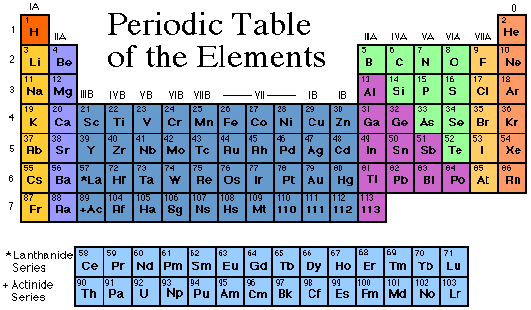

Periodic Table of the Elements (Credit: NASA)
[/caption]
Today, November 4, 2011, the General Assembly of the International Union of Pure and Applied Physics (IUPAP) is meeting at the Institute of Physics in London, to approve the names of three new elements… one of which will honor the great Copernicus. Their names are: Element 110, darmstadtium (Ds), Element111, roentgenium (Rg) and Element 112. copernicium (Cn).
Are these new elements? Probably not. All the new ones were discovered long ago, but groups like IUPAC elect names to be used in scientific endeavors. Not only does this include the element, but new molecules which belong to it. As a general rule, these “new elements” are given names by their discoverer – which also leads to international debate. The elements can be named after a mythological concept, a mineral, a place or a country, a property or a very known scientist… even an astronomer!
As for element 112, this extremely radioactive synthetic element can only be created in a laboratory. Copernicium was created on February 9, 1996 by the Gesellschaft für Schwerionenforschung, but its original name – ununbium – didn’t get changed until almost two years ago when a German team of scientists provided enough information to prove its existence. When it was time to give it a moniker, the rules were that it had to end in “ium” and it couldn’t be named for a living person. On February 19, 2010, the 537th anniversary of Copernicus’ birth, IUPAC officially accepted the proposed name and symbol.
This “name calling” process comes from the Joint Working Party on the Discovery of Elements, which is a joint body of IUPAP and the International Union of Pure and Applied Chemistry (IUPAC). From there it is given to the General Assembly for approval. Dr. Robert Kirby-Harris, Chief Executive at IOP and Secretary-General of IUPAP, said, “The naming of these elements has been agreed in consultation with physicists around the world and we’re delighted to see them now being introduced to the Periodic Table.”
The General Assembly consists of 60 members from different countries. These delegates are elected from national academies and physical societies around the world. The five day meeting, which started session on Monday, October 31 will end today. The meeting included presentations from leading UK physicists, and the inauguration of IUPAP’s first female President, Professor Cecilia Jarlskog from the Division of Mathematical Physics at Lund University in Sweden.
Original Story Source: Institute of Physics News Release.
Back in the 60’s and 70’s it was all about the Moon. The Apollo program…
NASA’s Curiosity Rover has been exploring Mars since 2012 and, more recently has found evidence…
Gas is the stuff of star formation, and most galaxies have enough gas in their…
The ISS's orbit is slowly decaying. While it might seem a permanent fixture in the…
What came first, galaxies or planets? The answer has always been galaxies, but new research…
The Andromeda galaxy is our closest galactic neighbour, barring dwarf galaxies that are gravitationally bound…